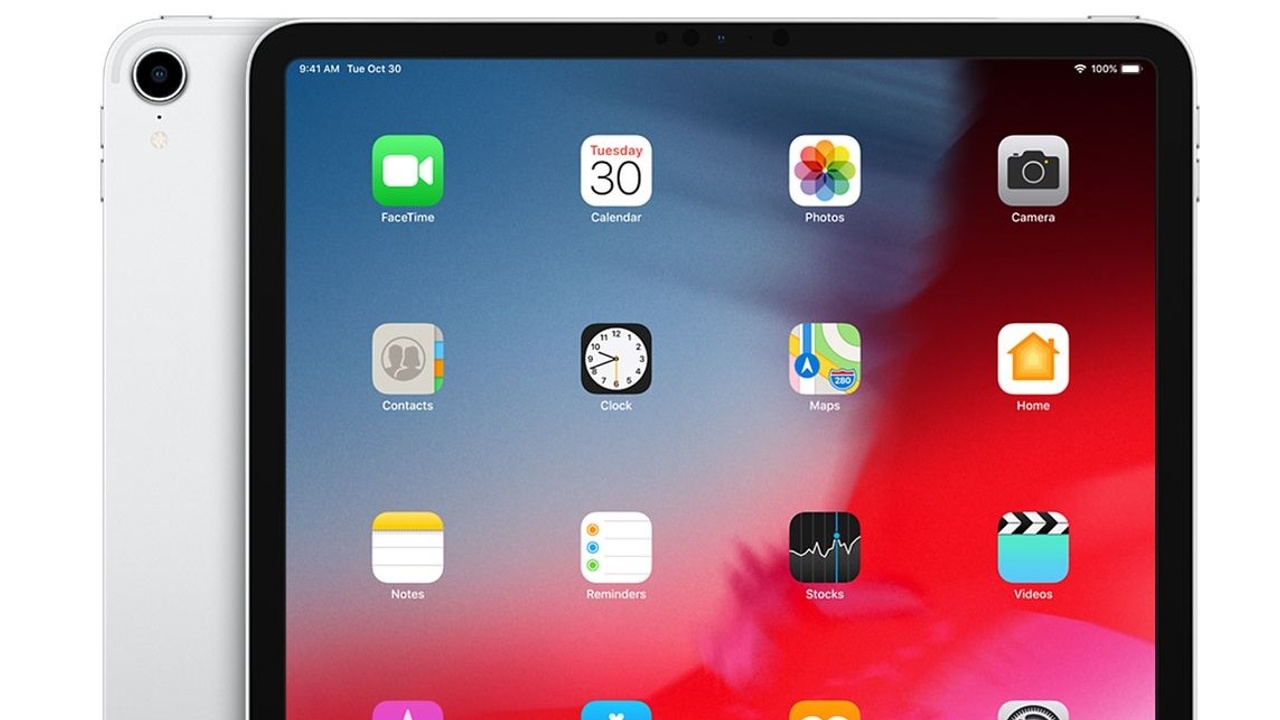
Digital sheet music has come a very long way since the awkward initial attempts to turn laptops into contortionists a few daring musicians hoped would miraculously stay on a music stand. For several years, I’ve kept a digital score library on an iPad to supplement the traditional paper scores I use for learning and practicing. Is it finally time to embrace technology fully and go all-digital? Here is one musician’s perspective on the iPad as a digital sheet music reader.
Which size should you get?
With the introduction of a new 10.5“ model, iPads now come in four sizes: the iPad Mini with a 7.9” screen, the “standard” iPad at 9.7“, and two iPad Pro models, with 10.5” and 12.9" displays. (Screen sizes are measured diagonally as a standard.) Rumor has it that the iPad Mini will be phased out now that iPhones have very large screens; also, they’re too small to be all that useful for sheet music.
My own current model is the 9.7“ Pro from 2016, which has just been supplanted by the 10.5” model in Apple’s lineup. I compared the two mid-sized models side by side to get an idea of how they perform for musicians, especially for sheet music. It turns out there’s really not much difference in size between the 9.7“ and 10.5” models as far as sheet music is concerned. I expected the difference to be much bigger.
The 9.7" model is exactly the same size as Henle’s study score editions – to the millimeter, in fact:
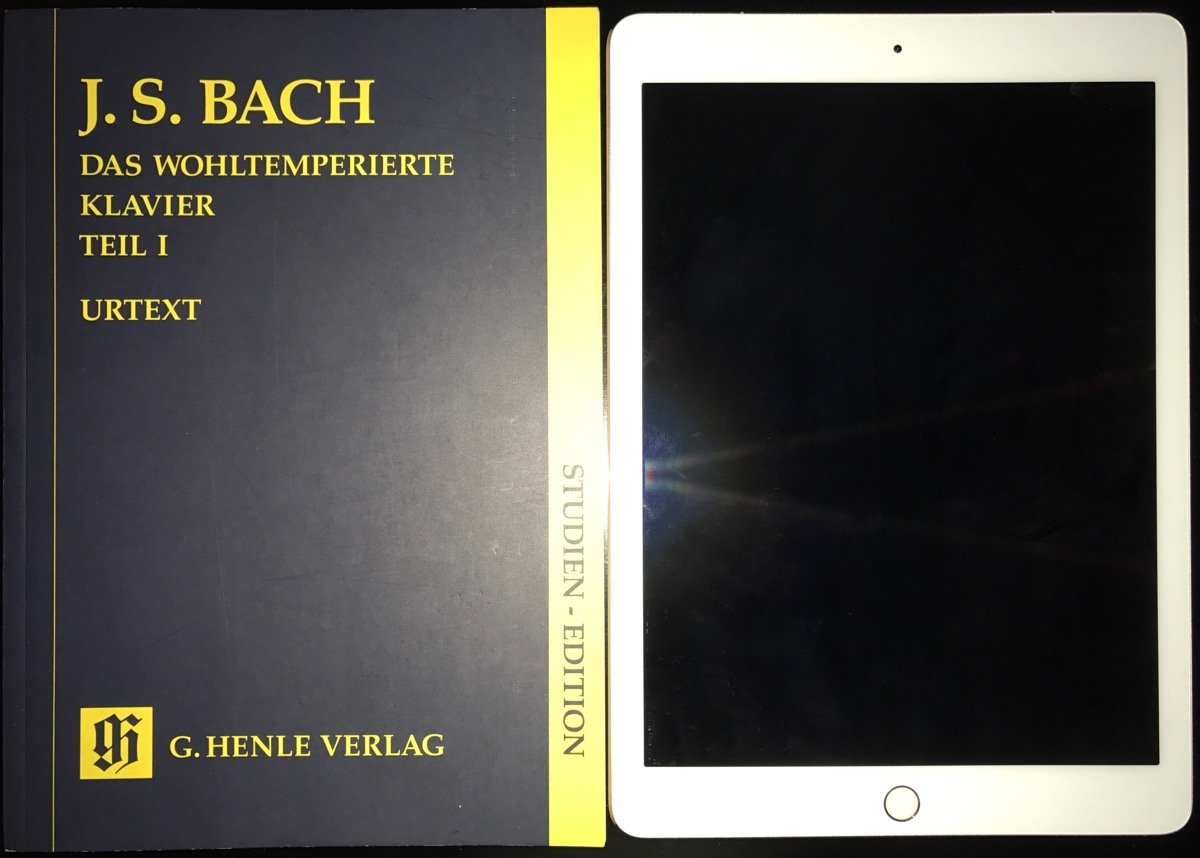
Here is the 9.7" iPad on top of a Henle study score:
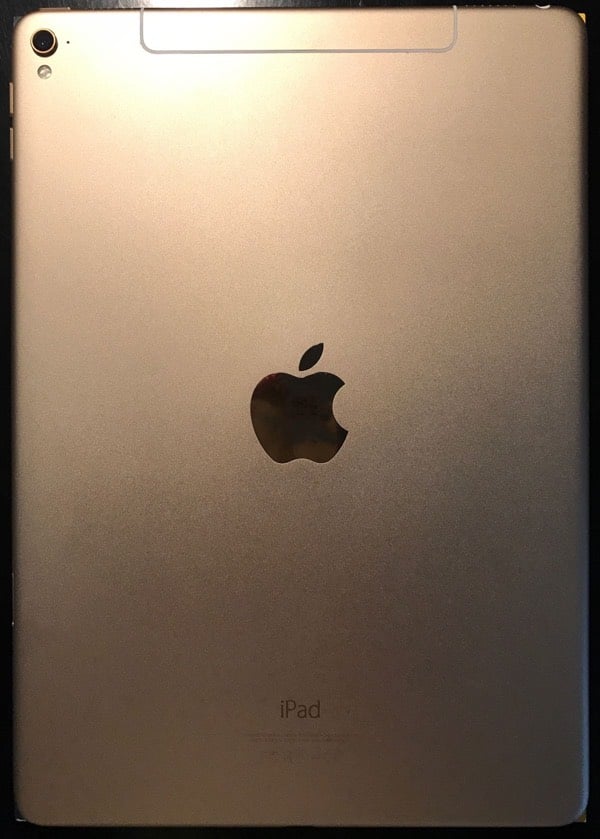
You can barely see the corners of the print edition, showing that it’s the same size as the 9.7" iPad.
When you compare the margins of Henle’s study scores with the bezel of the 9.7" iPad plus the margins of a score on the screen, the music appears at about the same size.
Henle incidentally also has an app called Henle Library for their sheet music, which you can now purchase digitally. Here’s a Beethoven piano sonata (Op. 14, No. 1) in the Henle app placed next to the same piece in their study score edition:
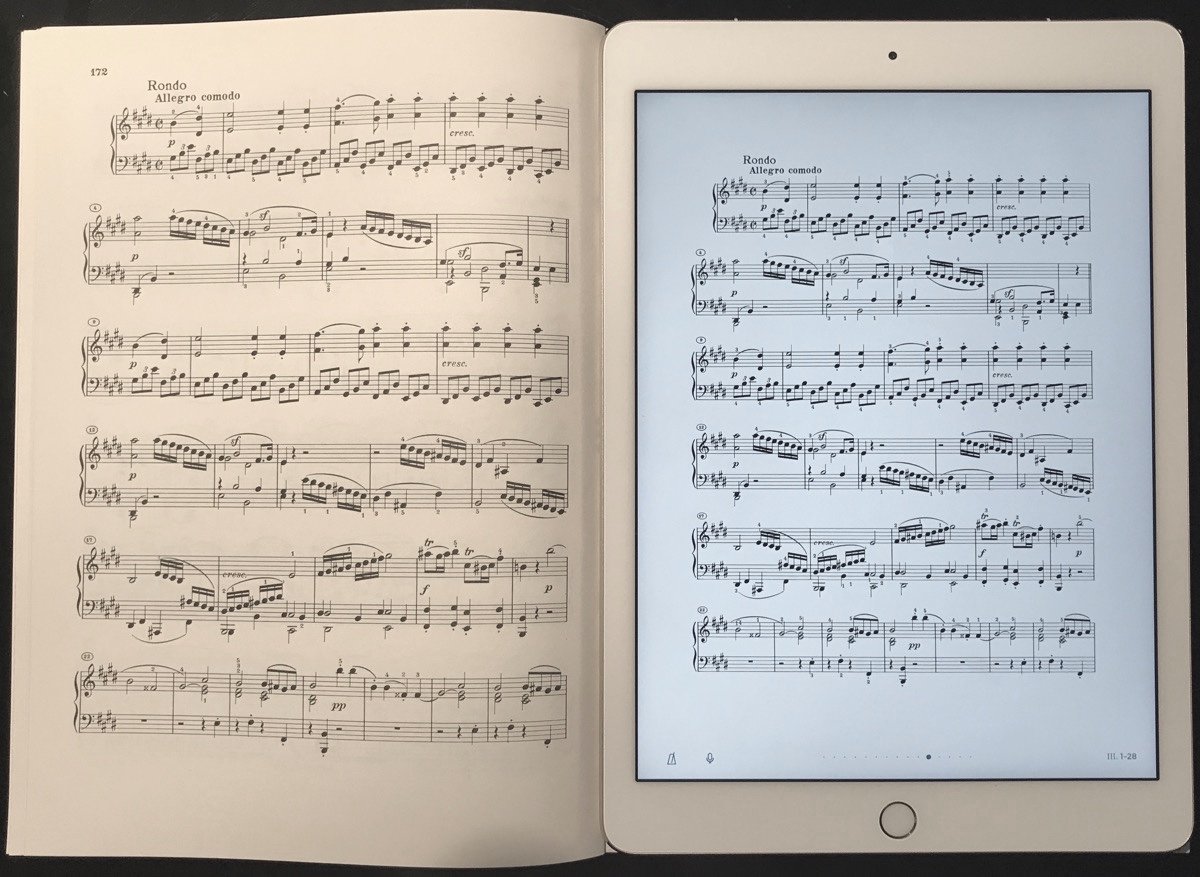
If you use the Henle app’s default printed layout, for some reason the margins are huge. You can change this in the score settings by selecting “custom layout.” Then you can adjust both the margins and the spacing between staves. Once you set the margins to something more typical, you can see that the digital edition and the printed study edition are basically the same size. You can even reduce the margins and make the music notation much bigger, even compared to the printed score:
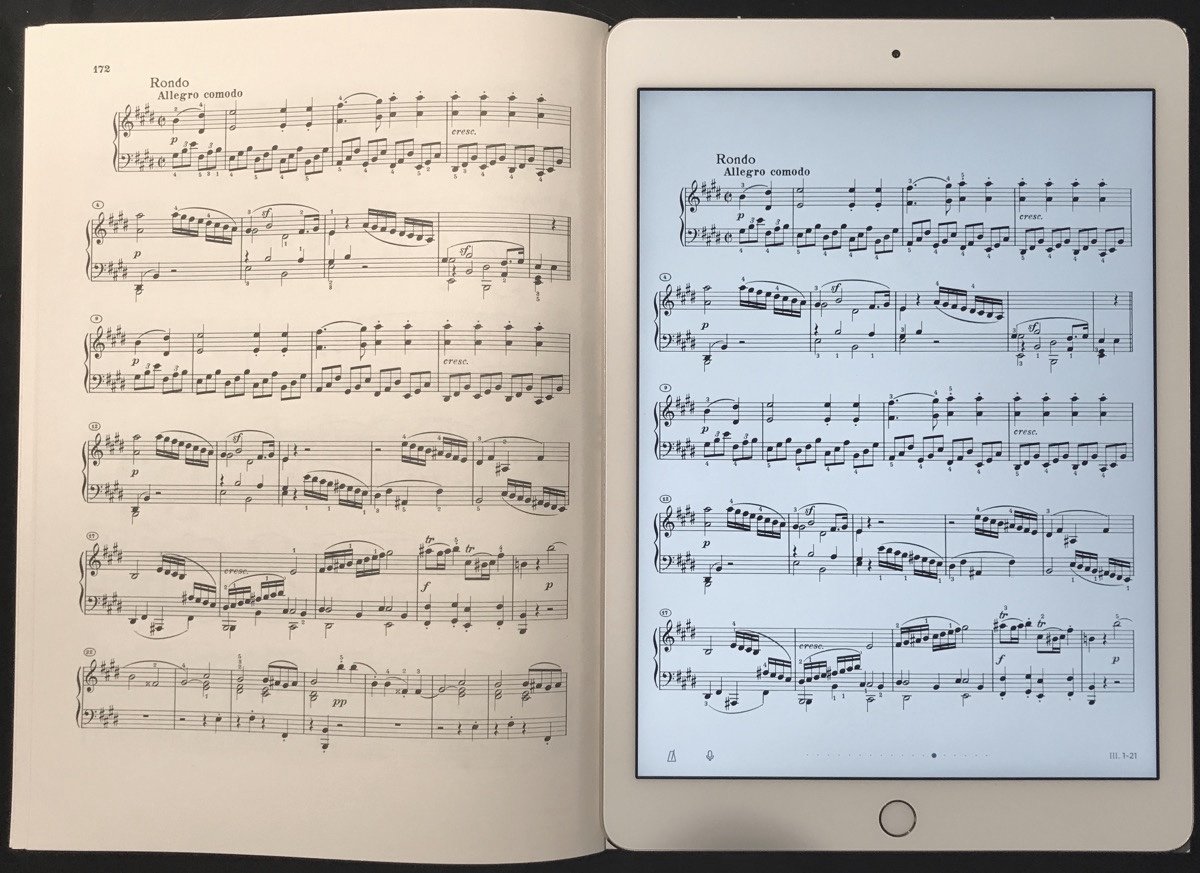
In summary, if you can read a study score or pocket score edition from various music publishers, you can just as easily read sheet music on the 9.7" iPad, if not more easily.
Personally, I like learning music with a full-size (printed) score, then using smaller study editions once I’ve learned a piece. I typically transfer my fingerings to the study score, then I carry around the smaller score. Now, with the iPad I can use the Apple Pencil to write in fingerings and just carry the iPad.
9.7“ vs. 10.5” for sheet music
You may be wondering how the two mid-size models compare for sheet music. At a store I compared the 9.7“ to the 10.5” model for this purpose. Here’s the same page of music on both models side by side:
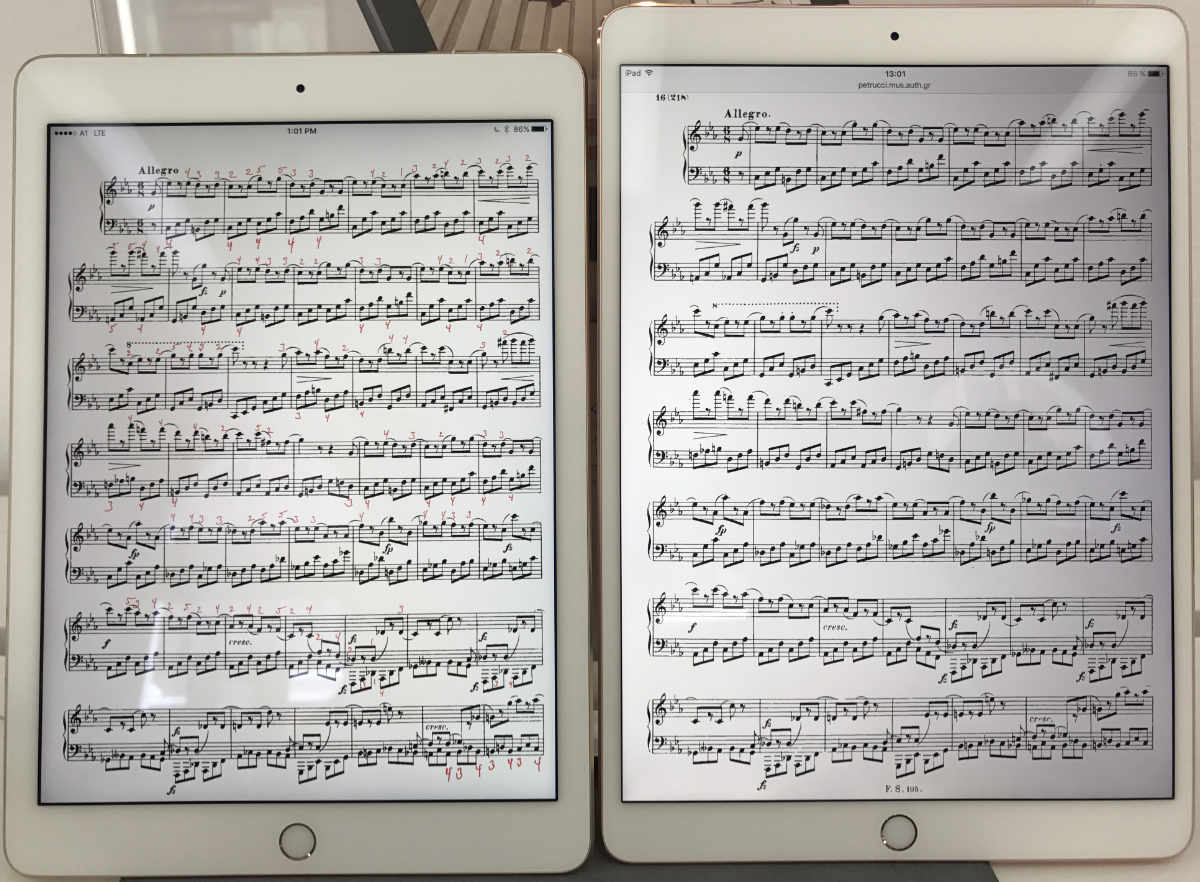
This is from Schubert’s C minor Sonata and it’s condensed from a significantly bigger score, so the notes are even smaller than most sheet music appears on the iPad. Still, while the slightly bigger screen is nice, it really only makes a minor difference, so it really doesn’t make sense to upgrade from 9.7 to 10.5“ based on the screen size if you’re going to be reading music on it. The 10.5” iPad Pro is a brilliant device for sure and certainly worth considering if you need its power – but the extra 0.8" doesn’t really make much of a difference for reading music.
Smart Keyboard
I also compared the Smart Keyboards. The keyboard for the 10.5“ model is only about 1 centimeter wider, which is enough to make the keys slightly bigger. I found that the bit of extra space indeed makes a difference, but it’s by no means night and day, just that much more pleasant to type on. (I’m typing this article on the Smart Keyboard for the 9.7” model without any trouble.) Again, the keyboard is not a compelling reason to upgrade if you already have the 9.7" Pro.
12.9" model
What does make a big difference is the 12.9" screen. This is about the size of a standard sheet of paper (US letter or A4). It’s the size you’re used to when you open a volume of sheet music. I find this size to be ideal for sheet music and was (and still am) tempted to get the big iPad Pro for music.
The obvious problem with the big iPad Pro is that it’s so big. The screen is beautiful, perfect for sheet music, but for most other things you do with a tablet it’s rather unwieldy. You can toss a small model – with Apple’s Smart Keyboard if you have it – into a bag and easily carry it around with you, taking it out when and if you need it, but you’ll have second thoughts doing so with the huge iPad, especially if you have an external keyboard, with its added weight. The smaller models can easily be held in one hand, not so their bigger sibling. I find the mid-size models perfect for all the things most people do with tablets: email, news, web browsing, social media, video and a game every now and then (my favorite is chess). The 12.9“ is just too big to hold in your hand and do normal ”tablet stuff" like you can on a smaller tablet, even though it’s perfect for sheet music.
Apple Pencil
One tool that in my opinion is really indispensable for musicians is a stylus. For iPad users this is the Apple Pencil. Like most professional musicians I write fingerings, articulation, dynamics, slurs and notes in my scores. For a long time this had been the iPad’s Achilles’ heel. As great as it was to be able to carry around a score library everywhere you went, the iPad’s utility for performing musicians was very limited by the inability to mark up the score easily. Sure, app developers came up with some workarounds, but none of them worked very well simply because there was no pencil or stylus, and a pencil is by far the easiest way to write in a score.
Fortunately all of this changes with the Apple Pencil. Importantly, it’s exclusive to iPad Pro models. The cheapest iPad Pro is about twice the price of the entry-level iPad, plus the Pencil is an additional $99 (or £99 or € 109 or thereabouts, depending on where you live). The price is therefore a real barrier to entry, with a base model 10.5" iPad Pro plus Pencil costing $750 (about £720 in the UK and around € 850 in Europe). Add a Smart Keyboard and it’s over $900 (over € 1000 in Europe, and that’s just for the base model). If you can live without a stylus, the standard (non-Pro) iPad is outstanding and will easily do most everything people use tablets for. If you’re a professional musician, though, you’ll probably want to get a Pro model with the Pencil for marking up your scores.
ProMotion
The 2017 models now have a screen that redraws 120 times per second, as opposed to the usual 60. Most reviewers have been impressed by the smooth animations and scrolling but have concluded that this isn’t a compelling reason to upgrade. My impression was the same. I was impressed by the smoothness but it’s definitely not a reason to upgrade from a 2016 Pro model, just a thoughtful feature that makes touching pictures on glass feel a bit more realistic. One reviewer for a major publication reported that he just couldn’t see a difference at all.
The latency with Apple Pencil is now even shorter. This might please graphic artists, but for annotating music notation it’s completely irrelevant and doesn’t affect the experience at all.
The only latency I’ve noticed on my 9.7" Pro occurs with the app I use most for sheet music, forScore – but this has nothing to do with the Apple Pencil’s latency or the screen refresh rate. If you set forScore to exit annotation mode immediately, there’s a small delay when you start writing. forScore takes a split second to enter annotation mode when you touch the screen with the Pencil.
In the iOS Notes app I’ve noticed zero latency with the Pencil and don’t see how this can be improved.
The ProMotion display is therefore certainly a welcome refinement but for musicians it won’t make a difference.
Sheet music apps
forScore is basically a PDF reader that has been optimized for sheet music. It has wonderful support for the Apple Pencil. You can starting writing with it and the app automatically switches to annotation mode, which offers a range of tools. It’s also compatible with Bluetooth pedal page turners.
forScore makes a tablet a viable alternative to printed sheet music for many applications. Personally, I still prefer to err on the side of caution, since technology inevitably follows Murphy’s Law. The other day I was practicing and tried to connect my AirTurn Ped Bluetooth pedal, but for reasons still unknown to me it just wouldn’t connect to my iPad (at least not in the mode AirTurn designed it for). I lost a good twenty minutes perusing the manual, support site and resetting my devices before giving up in despair. Had this happened backstage before a concert I would have panicked. Still, once I’ve already learned and memorized my program, it’s certainly far preferable to travel with an iPad than it is to carry a stack of books.
Recommendation
In conclusion, I recommend an iPad to all musicians. If you’re an amateur musician who still mostly uses paper, the regular, non-Pro iPad will be perfectly fine. You’ll have an excellent tablet for not too much money that you can also use for sheet music.
If you’re a professional musician or you plan on using your iPad for learning music scores, then an iPad Pro – be it 9.7“, 10.5” or 12.9" – is well worth looking into. I’d consider the Apple Pencil a mandatory accessory for professional musicians.
If you already have a 2016 model 9.7“ Pro, the extra little bit of screen real estate on the 10.5” model won’t make much of a difference for reading music. The 12.9" model, on the other hand, would be worth looking into since it’s the perfect size for sheet music, although it’s an expensive upgrade and it’s much less convenient for most other tablet tasks.
I’m extremely happy with my 9.7" Pro. I still learn most scores on paper, then I like to transfer my fingerings to the iPad using the Apple Pencil. This gives me the best of both worlds: the ease of paper and the portability and flexibility of a mid-size tablet.
Start Your NEW Piano Journey
Sign up below and each week for the next year, I'll send you a conservatory-quality 3- to 5-minute lesson sharing exclusive playing and practice techniques used by concert artists worldwide.
Each lesson has been carefully crafted to meet the needs of players ranging from beginners to the late intermediate level.
As a very special bonus, you'll also receive invitations to join our exclusive live Keys to Mastery™ monthly masterclasses.
We will never sell your information, for any reason.

